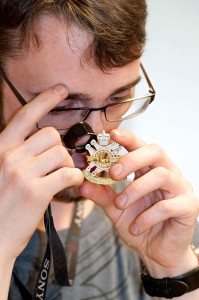Picking a path

These days, many students do not go on to work in jewellery stores or in manufacturing after graduating. Instead, they start their own companies, making custom pieces for their customers and working the craft show circuit. When their career path is centred on creating one-of-a-kind pieces, students place less emphasis on courses that focus on jewellery repair. At the same time, repair skills are very important for the average family-owned jewellery store, which tends to hire graduates from jewellery programs so they can have a goldsmith onsite. “I want someone who can sit at the bench and do the work,” states Adam LeBoeuf, owner of Bill LeBoeuf Jewellers in Barrie, Ont. While LeBoeuf is a GIA-certified gemmologist, he has limited bench skills and is not in a position to train someone to do repairs. “I’m not a teacher and I don’t have time to do it,” he laments. That leaves employers with employees who have many and varied bench skills, but not necessarily an abundance of advanced jewellery repair experience.
Colin Nash, owner of Nash Jewellers in London, Ont., understands the difficulties of providing students with relevant skills and how they meet the industry’s needs. “The students I hired do high-quality work,” he explains. “However, they both had previous experience in another shop, working under someone before coming here and that made a difference.”
Although he took an intensive three-month course in bench repair, Nash says that when he got back into the shop—and into a real-life environment—he didn’t feel fully prepared for the work asked of him. “Even after graduating, students still need a guide for a couple of years.”
Nash points to apprenticeship programs as a possible solution to the problem of training goldsmiths who specialize in repair work. Unfortunately, Canada has never had any formal jewellery apprenticeship training programs. In other industries, these initiatives are co-dependent, meaning the employer must legally commit to teaching the proscribed theory and practical techniques for an escalating rate of pay over the course of an apprenticeship, which might be five to seven years long. This training is complemented by mandatory trade school classes and curriculum. The apprentice signs on to work and learn for a set number of hours per week with a commitment to periodic reviews of progress by the employer. This type of apprenticeship, which works extremely well in other industries, is either officially recognized by provincial governments and/or industry watchdogs that are mandated to provide oversight.
Unfortunately, rather than formal goldsmithing apprenticeship programs recognized by the provincial governments, Canadian students rely on a dozen or so post-secondary educational institutions offering certificates, diplomas, and degrees of government-accredited courses. Matching want with need, availability, geographic proximity, and access is a challenge for the prospective student and employer. “If there isn’t someone to guide them, I suggest employers hire graduates who’ve had some real-life experience elsewhere,” Nash adds.
Brian Land, an independent retail jewellery consultant, says there is “an expectation [from the industry] that someone coming out of a jewellery program is a master jeweller and would be able to hit the ground running.”
“Yet, the people with these expectations are the same ones who were trained by a father or mother over eight years or more and possibly started out just polishing or only sizing one ring at a time, then having it checked for problems,” says Land, who is former vice-president of sales and operations for Peoples Jewellers. “It takes more than two or three years of school to produce a master jeweller.”





